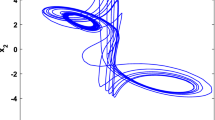Abstract
A non-fragile memory feedback control methodology is precisely proposed in this study for synchronization of hierarchical hybrid coupled neural networks (HHCNNs) over finite-time domain with mismatched quantization channels and external disturbances. Specifically, the considered network model incorporates both higher level deterministic switching and lower level Markov switching. Moreover, an undirected communication topology is selected to project the addressed HHCNNs. The foremost intention of this study is to substantiate the synchronization criterion over finite interval of time with proposed \(H_{\infty }\) disturbance attenuation. In consideration to this motive, by conferring Lyapunov stability theory in conjunction with average dwell-time technique, a collection of adequate conditions is established for assuring the exponential synchronization criterion through a set of linear matrix inequalities. Moreover, the desired the memory feedback controller with gain variations is computed based on the developed matrix inequalities. Finally, the developed theoretical results are validated through a numerical example, which showcases the significance and advantage of the developed control strategy.











Similar content being viewed by others
References
Chen J, Park JH, Xu S (2019) Stability analysis for neural networks with time-varying delay via improved techniques. IEEE Trans Cybern 49(12):4495–4500
Chen C, Li L, Peng H, Kurths J, Yang Y (2018) Fixed-time synchronization of hybrid coupled networks with time-varying delays. Chaos Solitons Fractals 108:49–56
Zhang L, Zhu Y, Zheng WX (2016) Synchronization and state estimation of a class of hierarchical hybrid neural networks with time-varying delays. IEEE Trans Neural Netw Learn Syst 27(2):459–470
Chen S, Jiang H, Lu B, Yu Z (2020) Exponential synchronization for inertial coupled neural networks under directed topology via pinning impulsive control. J Franklin Inst 357(3):1671–1689
Wang J, Zhang H, Wang Z, Gao DW (2017) Finite-time synchronization of coupled hierarchical hybrid neural networks with time-varying delays. IEEE Trans Cybern 47(10):2995–3004
Cui Y, Liu Y, Zhang W, Alsaadi FE (2018) Stochastic stability for a class of discrete-time switched neural networks with stochastic noise and time-varying mixed delays. Int J Control Autom Syst 16(1):158–167
Hu X, Xia J, Wei Y, Meng B, Shen H (2019) Passivity-based state synchronization for semi-Markov jump coupled chaotic neural networks with randomly occurring time delays. Appl Math Comput 361:32–41
Xiao J, Zeng Z (2020) Finite-time passivity of neural networks with time varying delay. J Franklin Inst 357:2437–2456
Tian Y, Wang Z (2021) A new result on \(H_\infty \) performance state estimation for static neural networks with time-varying delays. Appl Math Comput 388:125556
Zhang Z, Cao J (2019) Novel finite-time synchronization criteria for inertial neural networks with time delays via integral inequality method. IEEE Trans Neural Netw Learn Syst 30(5):1476–1485
Zhang Z, Ren L (2019) New sufficient conditions on global asymptotic synchronization of inertial delayed neural networks by using integrating inequality techniques. Nonlinear Dyn 95(2):905–917
Liu Y, Park JH, Guo BZ, Fang F, Zhou F (2018) Event-triggered dissipative synchronization for Markovian jump neural networks with general transition probabilities. Int J Robust Nonlinear Control 28(13):3893–3908
Han Y, Lian J (2019) Synchronization of switched neural networks with time-varying delays via sampled-data control. Asian J Control 21(3):1260–1269
Li S, Peng X, Tang Y, Shi Y (2018) Finite-time synchronization of time-delayed neural networks with unknown parameters via adaptive control. Neurocomputing 308:65–74
Ding K, Zhu Q, Liu L (2019) Extended dissipativity stabilization and synchronization of uncertain stochastic reaction-diffusion neural networks via intermittent non-fragile control. J Franklin Inst 356(18):11690–11715
Zhao J, Wang J, Park JH, Shen H (2015) Memory feedback controller design for stochastic Markov jump distributed delay systems with input saturation and partially known transition rates. Nonlinear Anal Hybrid Syst 15:52–62
Chen Y, Wang Z, Qian W, Alsaadi FE (2017) Memory-based controller design for neutral time-delay systems with input saturations: a novel delay-dependent polytopic approach. J Franklin Inst 354(13):5245–5265
Karthick SA, Sakthivel R, Alzahrani F, Leelamani A (2019) Synchronization of semi-Markov coupled neural networks with impulse effects and leakage delay. Neurocomputing 386:221–231
Sakthivel R, Joby M, Anthoni SM (2017) Resilient dissipative based controller for stochastic systems with randomly occurring gain fluctuations. Inf Sci 418–419:447–462
Ji Liu, Zha L, Xie X, Tian E (2018) Resilient observer-based control for networked nonlinear T-S fuzzy systems with hybrid-triggered scheme. Nonlinear Dyn 91(3):2049–2061
Liu D, Yang GH (2018) Event-triggered non-fragile control for linear systems with actuator saturation and disturbances. Inf Sci 429:1–11
Huo S, Chen M, Shen H (2017) Non-fragile mixed \(H_{\infty }\) and passive asynchronous state estimation for Markov jump neural networks with randomly occurring uncertainties and sensor nonlinearity. Neurocomputing 227:46–53
Luo J, Tian W, Zhong S, Shi K, Wang W (2018) Non-fragile asynchronous event-triggered control for uncertain delayed switched neural networks. Nonlinear Anal Hybrid Syst 29:54–73
Shi K, Zhong S, Tang Y, Cheng J (2020) Non-fragile memory filtering of TS fuzzy delayed neural networks based on switched fuzzy sampled-data control. Fuzzy Sets Syst 394:40–64
Yang X, Feng Y, Yiu KFC, Song Q, Alsaadi FE (2018) Synchronization of coupled neural networks with infinite-time distributed delays via quantized intermittent pinning control. Nonlinear Dyn 94(3):2289–2303
Wan Y, Cao J, Wen G (2017) Quantized synchronization of chaotic neural networks with scheduled output feedback control. IEEE Trans Neural Netw Learn Syst 28(11):2638–2647
Shen M, Nguang SK, Ahn CK, Wang QG (2019) Robust \(H_2\) control of linear systems with mismatched quantization. IEEE Trans Autom Control 64(4):1702–1709
Qi W, Park JH, Zong G, Cao J, Cheng J (2020) Synchronization for quantized semi-Markov switching neural networks in a finite time. IEEE Trans Neural Netw Learn Syst 32(3):1264–1275
Jian J, Duan L (2020) Finite-time synchronization for fuzzy neutral-type inertial neural networks with time-varying coefficients and proportional delays. Fuzzy Sets Syst 381:51–67
Zhang D, Cheng J, Cao J, Zhang D (2019) Finite-time synchronization control for semi-Markov jump neural networks with mode-dependent stochastic parametric uncertainties. Appl Math Comput 344–345:230–242
Liu C, Guo Y, Rao H, Lin M, Xu Y (2021) Finite-time synchronization for periodic T-S fuzzy master-slave neural networks with distributed delays. J Franklin Inst 358(4):2367–2381
Author information
Authors and Affiliations
Corresponding author
Ethics declarations
Conflict of interest
The authors declare that they have no conflict of interest concerning the publication of this manuscript.
Additional information
Publisher's Note
Springer Nature remains neutral with regard to jurisdictional claims in published maps and institutional affiliations.
Appendix I
Appendix I
Taking advantage of infinitesimal operator [18] indicated here as \({\mathcal {L}}\) on (18), we attained the following equations:
Now, by the agency of Jensen’s inequality [16], the integral terms in (31) can be simplified as follows:
According to \(\pi _{qn}\ge 0 (q\ne n),\ Q_{n}\ge 0\) and (13), we have
Following the same methodology as above, we can get
Moreover, by utilizing Assumption 1, we can retrieve the following inequalities:
where \(\varSigma _1\) and \(\varSigma _{2,p,q}\) are formerly described in theorem statement.
At the same instant, for any non-singular pertinent matrix \(W_{p,q}\), the following equation holds:
Further, from (28)-(39) with addition of \(z^{T}(s)z(s)-\gamma ^2 w^{T}(s)w(s)\) and taking mathematical expectations, we can easily fetch that
Moreover, from relations (12) and (40), it is easy to obtain
where \(\varTheta (t,p,q)=\bigg [\varPsi ^{T}(t) \ \ \varPsi ^{T}(t-\tau _{p,q}(t)) \ \ \varPsi ^{T}(t-\tau ^1_{p,q}(t)) \ \varPsi ^{T}(t-\tau ^2_{p,q}(t)) \ \ g^{T}(\varPsi (t)) \ \ g^{T}(\varPsi (t-\tau _{p,q}))\ \ {\dot{\varPsi }}^{T}(t)\ \ w^{T}(s) \bigg ]^\mathrm{T}.\)
Further, multiplying \(e^{-\alpha t}\) and integrating (41), we get
Moreover, in light of (15)-(17) and (40), we acquire
Based on the relations (42) and (43), and setting the recursion from \(t_{k-1}\) to \(t_k\), \(t_{k-2}\) to \(t_{k-1}\), \(\ldots \) up to \(t_0\), we bring off inequality by
Then, by letting \({\tilde{P}}_{p,q}={\mathfrak {D}}_{p,q}^{-\frac{1}{2}}P_{p,q}{\mathfrak {D}}_{p,q}^{-\frac{1}{2}}, {\tilde{Q}}_{1,p,q}={\mathfrak {D}}_{p,q}^{-\frac{1}{2}}Q_{1,p,q}{\mathfrak {D}}_{p,q}^{-\frac{1}{2}},\quad {\tilde{R}}_{1,p,q}={\mathfrak {D}}_{p,q}^{-\frac{1}{2}}R_{1,p,q}{\mathfrak {D}}_{p,q}^{-\frac{1}{2}}, {\tilde{S}}_{1,p,q}={\mathfrak {D}}_{p,q}^{-\frac{1}{2}}S_{1,p,q}{\mathfrak {D}}_{p,q}^{-\frac{1}{2}},\quad {\tilde{Q}}={\mathfrak {D}}^{-\frac{1}{2}}Q{\mathfrak {D}}^{-\frac{1}{2}}, {\tilde{R}}={\mathfrak {D}}^{-\frac{1}{2}}R{\mathfrak {D}}^{-\frac{1}{2}},\quad {\tilde{S}}={\mathfrak {D}}^{-\frac{1}{2}}S{\mathfrak {D}}^{-\frac{1}{2}},\ \tilde{E_1}={\mathfrak {D}}^{-\frac{1}{2}}E_1{\mathfrak {D}}^{-\frac{1}{2}}, \tilde{E_2}={\mathfrak {D}}^{-\frac{1}{2}}E_2{\mathfrak {D}}^{-\frac{1}{2}}\) and it is easy to obtain
Furthermore from (18), it follows that
From (44), we can get
Then, in accordance with (46) and (48), we have
From the relation (14), it is obvious that \({\mathbb {E}}\{\varPsi (t){\mathfrak {D}}_{p,q}\varPsi (t)\}<C_2 \ \forall t \in [0,{z}]\). Hence, finite-time exponential synchronization of HHCNNs (1) is achieved in accordance with Definition 2.1 of [30] under the control design (5). Thus, the proof of this theorem ends.
Rights and permissions
About this article
Cite this article
Sakthivel, R., Aravinth, N., Aouiti, C. et al. Finite-time synchronization of hierarchical hybrid coupled neural networks with mismatched quantization. Neural Comput & Applic 33, 16881–16897 (2021). https://doi.org/10.1007/s00521-021-06049-9
Received:
Accepted:
Published:
Issue Date:
DOI: https://doi.org/10.1007/s00521-021-06049-9




